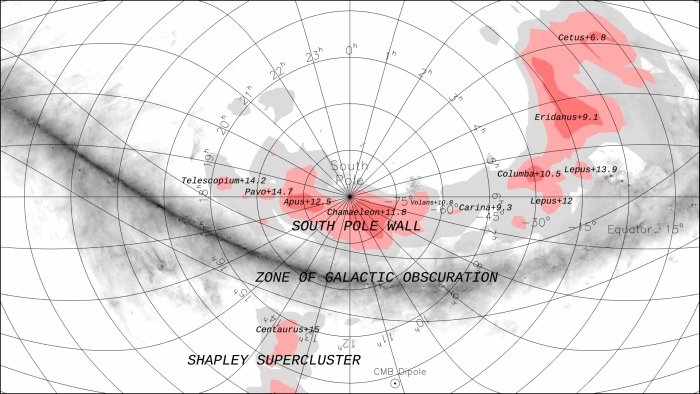A Large ‘Wall’ of Galaxies Has Been Discovered Stretching Throughout The Universe

The Universe is not only a random scattering of galaxies sprinkled all through an increasing void. The nearer we glance, the extra we see that there are constructions – a few of that are incomprehensibly huge groupings and clusters of galaxies which are gravitationally sure collectively.
Such a construction has simply been found arcing throughout the southern fringe of the sky, and it is a colossus, spanning an immense 1.37 billion light-years from finish to finish. Its discoverers have named it the South Pole Wall.
Though the scale is outstanding – it is one of many largest constructions in area we have ever seen – we all know precisely what the South Pole Wall is. It is a galaxy filament, an enormous formation of galaxies that kinds a border between the empty areas of cosmic voids that collectively type the cosmic internet. Therefore, we name it a wall.
Different, bigger such partitions are identified. The most important is the Hercules-Corona Borealis Nice Wall, which spans 9.7 billion light-years. However the South Pole Wall is particular, as a result of it is insanely near the Milky Method galaxy, mendacity simply 500 million light-years away. In different phrases, it’s the most large construction we have ever seen this shut.
You are in all probability questioning how on Laniakea we managed to overlook one of many largest galaxy filaments within the Universe proper on our doorstep. And there is truly a extremely good reply to that query: it was hidden behind what astronomers typically name the Zone of Avoidance or Zone of Galactic Obscuration – the Milky Method galactic airplane.
That is the disc of our dwelling galaxy, a area thick and vivid with mud and fuel and stars. So thick and vivid, actually, that it obscures a big a part of what’s behind it, making that area of the Universe poorly explored in comparison with the remaining.
If this Zone of Avoidance hid the South Pole Wall so successfully, how have astronomers discovered it now? The reply to that query is a bit more complicated, however mainly, it hinges on how galaxies transfer across the sky.
A crew of researchers led by cosmographer Daniel Pomarède of the Paris-Saclay College used a database referred to as Cosmicflows-Three, which comprises distance calculations to just about 18,000 galaxies. These are discovered utilizing redshift, which measures how quickly one thing is shifting farther away based mostly on how stretched out its mild waves are.
Final 12 months, a unique crew of researchers used this database to calculate one other parameter, one thing referred to as peculiar velocity, which is the speed of a galaxy relative to its movement because of the growth of the Universe.
With these two parameters, the crew may calculate the motions of the galaxies relative to one another – and these motions revealed the gravitational affect of a a lot bigger mass. With the assistance of algorithms, the crew was in a position to make use of these motions to map in three dimensions the distribution of fabric within the South Pole Wall, even past the Zone of Avoidance.
(Pomarède et al., ApJ, 2020)
The densest part lies over the South Pole – this half is the part that is 500 million light-years away. Then it curves north and in the direction of us, coming inside 300 million light-years of the Milky Method.
Alongside the curving arm, the galaxies are shifting in the direction of the clump on the South Pole; and from there, they’re shifting in the direction of one other big construction, the Shapley Supercluster 650 million light-years away.
As a result of there are components of the South Pole Wall we won’t see, it is attainable that the construction is even bigger than we will inform at this level. However we will make certain that astronomers are itching to seek out out.
For one, it may have attention-grabbing cosmological implications, affecting the speed of growth of the native Universe. This may increasingly or might not play a task within the Hubble Pressure, the distinction between the speed of growth within the native Universe and the speed of growth within the early Universe.
It may additionally assist us perceive the evolution of our native nook of area, which incorporates Laniakea, the supercluster of galaxies to which the Milky Method belongs, additionally found by Pomarède and his colleagues (led by Brent Tully of the College of Hawai’i at Manoa) again in 2014.
This can be a magnificent discovery, and we won’t wait to see what else it should reveal.
The analysis has been revealed in The Astrophysical Journal.